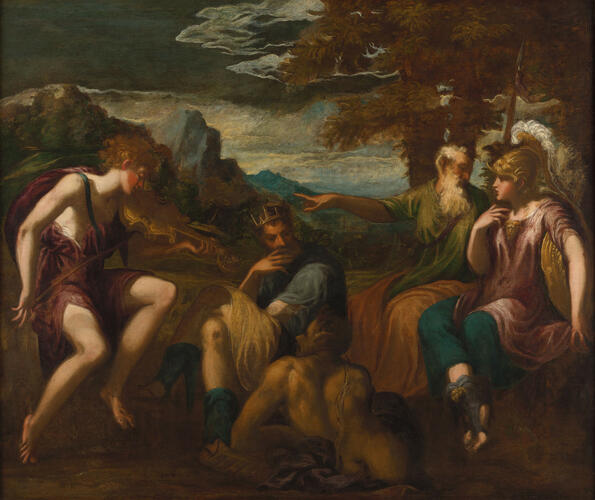-
1 of 253523 objects
The Judgement of Midas c. 1548-50
Oil on canvas | 167.6 x 197.7 cm (support, canvas/panel/stretcher external) | RCIN 402862
-
Schiavone was highly valued by Stuart collectors as a Venetian Mannerist working in the tradition of Bellini, Giorgione and Titian. His popularity has diminished over time, but the monograph exhibition at Venice's Museo Correr in 2016 is part of a wider attempt reinstate the artist's prior distinction.
The story comes from Ovid’s Metamorphoses (XI, 146-93): Pan boasts that his reed pipes make better music than Apollo’s lyre. Tmolus, the local mountain god, judges the contest and pronounces Apollo the winner. Midas, King of Phrygia, is on the mountain as a votary of Pan and disputes the verdict and as a punishment Apollo gives him ass’s ears. Apollo’s stringed instrument is shown as a lira de braccio (a seven- stringed precursor of the modern violin) rather than the ancient lyre (a type of hand-held harp), though it was regarded as an ancient instrument and a descendant of the lyre. Tmolus turns to Minerva, who here has a Medusa-head breastplate and is seated on the extreme right, and points to Apollo as the victor. But Pan, reclining on the ground, is still listening, resting his arm on his instrument, the pipes, and Midas seated in the centre, remains enraptured of Pan; his right ear is slightly too long, hinting at his future ass’s ears. Minerva is witnessing the contest. She is said to have invented the pipes, but when the other gods ridiculed her distorted face when playing them, she threw them away and cursed them. The satyr Marsyas picked them up and lost the other famous musical contest with Apollo, which resulted in him being flayed alive.Schiavone here uses a coarsely woven twill canvas. It is typical of his technique to paint highlights in white, over which he added translucent glazes to model from light to deep shadow. Here the figures are caught in the dramatic light falling from the left, which creates abrupt transitions. Apollo and Minerva (the only two Olympians), with smoother and whiter skin, match in colour and bracket the composition. Tmolus is by contrast, shaggy and set against the trees to suggest Ovid’s description of him: ‘The aged judge took his seat upon his own mountain-top, and shook his ears free from the trees’ (‘Monte suo senior iudex consedit et aures liberat arboribus’. Metamorphoses, XI, 157).
The technique is rapid, brushy and free: the feet speedily indicated, the fingers expressive rather than anatomically correct, the lira da braccio at an unresolved angle. The contrasts throughout the painting have become more exaggerated with age. A glaze may have been lost in the flesh tones making the transitions more abrupt. Schiavone frequently left a reserve in places around the edges of the figures which now appear as dark outlines, for example the profile of Apollo’s face, but these are not painted but simply the ground that has darkened with age. The trunks of the trees were painted over the ground with a brown glaze which has become more transparent, allowing the ground to show through. The dark blue of the sky is possibly an azurite or another copper colour which has darkened. The artist must have intended a more natural transition between the unusually schematic white clouds and the blue of the sky, which now as a thunderous look. The painting was conserved in 1997-98 when two layers of overpaint were removed from the sky. No evidence was found of the very different sky in the Simon Gribelin engraving dated 1712, which suggests that the sky was reworked before that date or the engraver decided to have a different sky in his print. A previous restorer gave Midas ass’s ears (removed in the 1997-98 restoration), when in fact Schiavone had barely indicated them.The composition was not radically changed in the painting process but many pentiments and some planning lines are visible in the paint and can be seen in the x-ray since Schiavone worked directly on the canvas. The x-ray shows that Apollo’s right leg was in a more upright position initially or there was some indication of what he is resting on; a different bow was indicated across the lira da braccio. If the bow was held at a different angle Apollo’s right arm would have to cross his body, of which there is no indication apart from some long strokes across Apollo’s chest. There are alternative folds in Minerva’s drapery; some drapery hung down from Tmolus’s extended right arm and Pan’s head and legs were painted over drapery.
Provenance
Gerard Reynst, Amsterdam; acquired by the States of Holland and West Friesland and presented to Charles II in 1660; listed in the 2nd Privy Lodging Room at Whitehall in 1666 (no 169)
-
Medium and techniques
Oil on canvas
Measurements
167.6 x 197.7 cm (support, canvas/panel/stretcher external)
Category
Object type(s)
